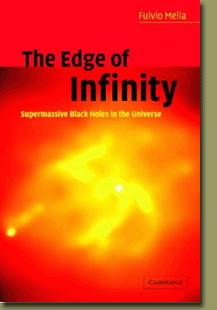 The
Edge of Infinity: Supermassive Black Holes in the
Universe
The
Edge of Infinity: Supermassive Black Holes in the
UniverseEdition: HARDCOVER Publisher: Cambridge University Press ISBN: 0521814057 158 pages, 5 half-tones, 39 color plates September 4, 2003 ABOUT THE BOOK In the past, they were recognized as the most destructive force in nature. Now, following a cascade of astonishing discoveries, supermassive black holes have undergone a dramatic shift in paradigm. Astronomers are finding out that these objects may have been critical to the formation of structure in the early universe, spawning bursts of star formation, planets, and even life itself. They may have contributed as much as half of all the radiation produced after the Big Bang, and as many as 200 million of them may now be lurking through the vast expanses of the observable cosmos. In this elegant, non-technical account, Melia conveys for the general reader the excitement generated by the quest to expose what these giant distortions in the fabric of space and time have to say about our origin and ultimate destiny. AWARDS Selected as one of the year's best astronomy books in the 2005 Annual Special Issue of Astronomy. REVIEWS "...Il libro di Fulvio Melia e un volumetto agile, ricco d'illustrazioni, in stile assolutamente divulgativo, ma con molti spunti originali e interessanti. Forse i piu coinvolgenti li si trova al terzo capitolo, quando l'autore affronta due argomenti squisitamente fisici, vale a dire la possibilita che l'Universo in cui viviamo sia costituito non da quattro, ma da undici dimensioni (di cui una temporale), come richiesto dalle teorie delle stringhe, e, nel paragrafo successivo, quando affronta le problematiche quantistiche che emergono nel collasso della materia verso la singolarita, al terzultimo stadio, quello caratteristico delle nane bianche. Melia tratta le due questioni in modo decisamente originale e attraente." Le Stelle "...Recently, astronomers have found a striking connection between the mass of a galaxy's supermassive black hole and the orbital speed of the stars in its outermost regions. Since such stars are way beyond the gravitational reach of the central black hole, the discovery can only mean that the stars and black hole somehow influenced each other in the past. Suddenly, we realised that the birth of galaxies was intimately connected with the birth of supermassive black holes. No one knows what came first - whether galaxies "seeded" supermassive black holes or vice versa, or whether the relationship was more symbiotic than either scenario. But there can be little doubt now that supermassive black holes, far from being at the periphery of those radar screens, are now at the dead centre. In The Edge of Infinity, University of Arizona astronomer Fulvio Melia tells the fascinating story of supermassive black holes, beautifully illustrated with stunning colour plates..." Marcus Chown, New Scientist |